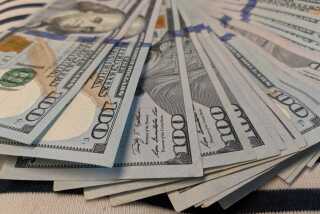Euro climbs to a record as the dollar resumes slide
- Share via
The dollar is back to its losing ways against its rivals, cutting Americans’ purchasing power abroad but also boosting their returns on foreign investments.
The euro Tuesday tied its record high against the dollar, rising to $1.383 in New York, up from $1.381 on Monday and matching the peak reached July 24. At the start of the year the euro was worth $1.32.
The dollar also has been sliding in recent weeks against the British pound, the Japanese yen and Brazilian real, among other currencies.
“The dollar is broadly starting to weaken,” said Greg Gibbs, a currency strategist at ABN Amro in Sydney, Australia.
The catalyst for the greenback’s latest swoon is the expectation that the Federal Reserve next week will reduce short-term interest rates to bolster the economy and ease the credit crunch in financial markets.
Lower rates tend to depress a nation’s currency by giving foreign investors lower returns on investments denominated in it.
The dollar had been sinking for much of this year, then rallied modestly amid the global financial turmoil in August. The rally suggested that some U.S. and foreign investors were seeking a haven in the dollar. But that seems to have run its course.
The falling dollar means the cost of going abroad is rising for Americans, and that imports may become more expensive.
On the flip side, a weak dollar lifts U.S. investors’ returns on foreign stocks and bonds: As foreign currencies strengthen, overseas holdings are worth more when translated into dollars.
Case in point: The average European blue-chip stock is up 0.4% year to date in euros, but is up 5.3% in dollars.
More to Read
Inside the business of entertainment
The Wide Shot brings you news, analysis and insights on everything from streaming wars to production — and what it all means for the future.
You may occasionally receive promotional content from the Los Angeles Times.









